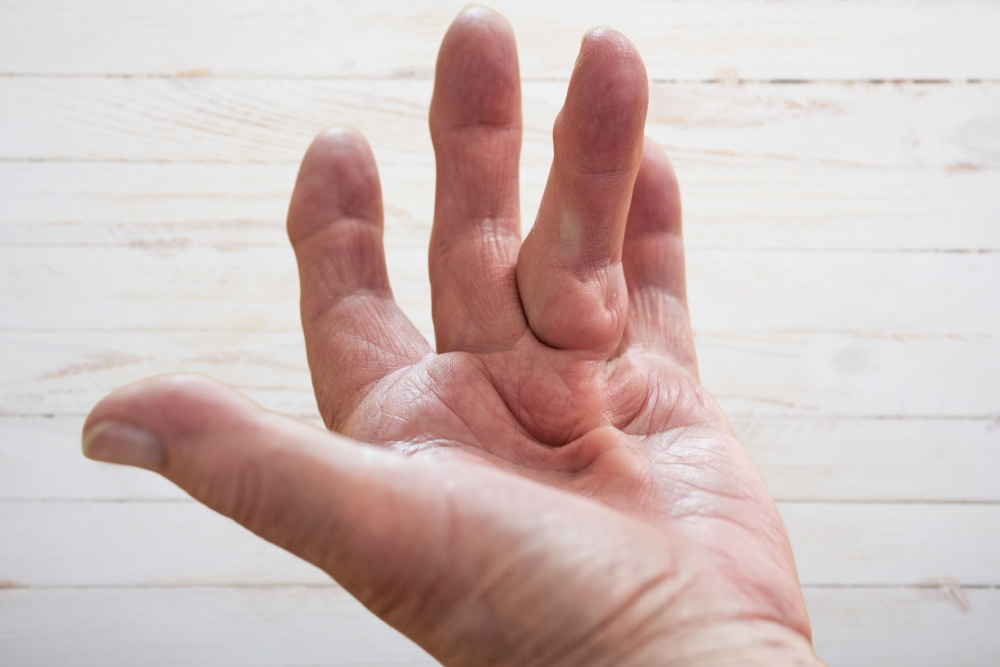What's On This Page?
ToggleI received this question and wanted to answer it publicly because it is about Dupuytren’s contracture, the fancy word for bent fingers! And that is something you may not have heard of, but it’s important because the symptoms at first, go under the radar. It starts with lumps in the palm.
Let’s begin this article with the actual question I received from Carolyn S. (Sacramento, California).
I have two small nodules in my palm, they are small and painless, but I see (and feel) them below my pinky and ring finger. My doctor’s appointment isn’t for two months and I’m worried. Can you weigh in?
I’m glad to hear that you have an appointment scheduled with your doctor, as professional assessment is key. It sounds like you’re describing symptoms that might be linked to a condition known as Dupuytren’s contracture. Of course, these nodules could be symptomatic of various conditions, but let’s focus on Dupuytren’s contracture for its distinct characteristics and my previous interest in exploring this lesser-known condition.
Dupuytren’s contracture begins as small, benign nodules, just as you described. They are often overlooked until they become more pronounced, accompanied by skin changes such as dimpling or pitting. In some cases, the fingers may start to bend towards the palm, which can be quite concerning.

Historically, figures such as Ronald Reagan, Samuel Beckett, and Margaret Thatcher have been afflicted, highlighting its widespread yet unpredictable nature. The progression from the initial appearance of nodules to significant contracture varies greatly—typically spanning months to years—and the severity can range from mild to quite severe.
Risk is Higher with Thyroid Disease
There is some evidence suggesting that Dupuytren’s contracture may be associated with certain systemic diseases, including thyroid disorders and autoimmune diseases, although the evidence is not entirely consistent. We do have enough data to see the correlation though. You might read through my other article, Expert Insights On Depression, Anxiety, Thyroid, Migraines And Celiac.
Thyroid Disease
Dupuytren’s contracture has been observed with somewhat greater frequency among people with thyroid disorders, especially hypothyroidism. The exact mechanism isn’t fully understood, but it is thought that metabolic changes associated with thyroid dysfunction and fluctuations with hormones might influence your connective tissue. This potentially leads to conditions like Dupuytren’s contracture and other tendon/ligament and joint problems. Thyroid hormones play a significant role in collagen synthesis and degradation, and imbalances could affect the fascial tissue in the palms.
Autoimmune Diseases
The relationship between Dupuytren’s contracture and autoimmune diseases is also another area of speculation. While Dupuytren’s contracture isn’t considered an autoimmune disease, it does share some characteristics typical of autoimmune conditions, like ongoing inflammation and changes in tissue structure.
Diseases like rheumatoid arthritis and systemic lupus erythematosus, which are clearly autoimmune, have been linked with a higher prevalence of fibrotic conditions, including Dupuytren’s. It’s not a direct cause, it just has something to do with the way this condition impact your ligaments and tissues, etc.
I’ve written many articles on autoimmune disease so I invite you to use my search box and type in relevant keywords to your situation. Since we are post-pandemic, you might be interested in, Long COVID: Natural Solutions And Autoimmune Insights.
Clinical Implications
These associations suggest that systemic inflammation and immune dysregulation, as seen in thyroid disorders and autoimmune diseases, could contribute to the fibrosis characteristic of Dupuytren’s contracture. It’s also possible that the presence of one chronic condition may simply make an individual more susceptible to developing others due to overlapping genetic, environmental, or lifestyle factors.
For those of you with thyroid disease, regular monitoring and effective management of your hormones and your health in general might help mitigate the risk or progression of Dupuytren’s contracture. Similarly, managing autoimmune diseases (whether through diet, medications or supplements) effectively and maintaining a healthy immune system could potentially reduce the risk of developing such fibrotic disorders.
If you have a thyroid disorder or an autoimmune disease and are concerned about Dupuytren’s contracture, it’s advisable to discuss these risks with your doctor, especially if you see a lump in your hand or feel the pull.
Recent Insights on Treatment Complications for Dupuytren’s
In trying to keep you informed with the most current research, I’ve come across a comprehensive systematic review and meta-analysis that sheds light on the complications associated with different treatments for Dupuytren’s contracture. The STUDY reviewed data from 26 studies involving over 10,000 patients, comparing outcomes from various interventions like collagenase injections, needle fasciotomy, and different types of surgical fasciectomies.
What’s particularly important for you to know is that the study highlighted a real need for better reporting on the complications of these treatments. For instance, infections occurred in about 4.5% of cases following limited fasciectomy, which is the most common surgical intervention. Nerve injuries and complex regional pain syndrome were other notable complications, with each occurring in about 3% of patients.
Even more critical to understand is that the more invasive the treatment, the higher the likelihood of complications. For example, open fasciotomy and dermofasciectomy, which are more extensive surgeries, showed higher risks for certain complications compared to less invasive procedures like needle fasciotomy. This latter procedure usually takes about 30 minutes and they do it straighten bent fingers caused by Dupuytren’s disease.
Integrating This Knowledge Into Your Care
Risk factors for Dupuytren’s contracture are diverse, including diabetes, genetics, and lifestyle factors like smoking and high alcohol intake. As your health advocate, I encourage you to discuss all available treatment options with your healthcare provider, considering both the potential benefits and the risks associated with each procedure.

In terms of non-surgical management, you might explore options like the drug “Tamoxifen,” which has been shown to reduce the fibrotic cytokine TGFβ, or consider dietary supplements like NAC, which may help slow the progression of tissue thickening.
Just FYI, here’s a fun fact: NAC stands for N acetylcysteine, and it’s usually used for thinning of mucus in the lungs, or as an antidote for acetaminophen poisoning.
Additionally, I came across a folk remedy involving magnesium oil, iodine, and DMSO, which some people apply topically to the affected area. As always, discuss any new treatment, including this remedy, with your physician before starting.
The folk remedy for Dupuytren’s contracture mentioned in the blog involves using a topical mixture that combines several ingredients known for their purported therapeutic effects. Here’s a detailed look at each component and the rationale behind its use:
- Magnesium Oil: This is not actually an oil but a concentrated solution of magnesium chloride in water. It is absorbed through the skin and is thought to reduce inflammation and help with muscle relaxation. For Dupuytren’s contracture, the idea is that magnesium might help relax the palmar fascia and reduce the tightness in the hand.
- Iodine: Iodine is known for its antiseptic properties, but it also plays a role in regulating tissue growth and repair. The theory here is that iodine might help modify the underlying tissue changes in Dupuytren’s contracture or prevent worsening of the condition.
- DMSO (Dimethyl Sulfoxide): DMSO is a solvent that is used topically to increase the absorption of other chemicals through the skin. It has anti-inflammatory and analgesic properties, which can help relieve pain and reduce inflammation in the affected area. Its inclusion in the remedy likely serves to enhance the penetration of magnesium and iodine into the tissues of the palm.

Preparation and Application:
- Mixing: Combine 5 ml (about 1 teaspoon) of topical Magnesium Oil with 20 to 30 drops of iodine and 10 drops of DMSO. It’s important to mix these in a glass container as DMSO can interact with certain plastics, potentially leading to contamination of the mixture.
- Storage: Store the mixture in an amber bottle to protect it from light, which can degrade iodine.
- Application: Apply a small amount of the mixture to the affected area of the palm using a cotton ball. It’s recommended to do this twice daily. The use of cotton balls helps in applying the solution without direct hand contact, minimizing any potential irritation from the DMSO.
Cautions:
- Consultation: Always consult with a healthcare provider before starting any new treatment, especially one involving substances like DMSO and iodine, which can have significant side effects if not used correctly.
- Skin Sensitivity: Both DMSO and iodine can cause skin irritation or allergic reactions in some people. It’s important to do a patch test before full application.
- Pregnancy and Breastfeeding: Avoid using such remedies if you are pregnant or breastfeeding, unless directed by a healthcare provider.
Summary
Always consult your doctor before starting any new treatment, especially alternatives like the above folk remedy. Early intervention and ongoing management can significantly impact the quality of life and progression of Dupuytren’s contracture. Remember, while waiting for your appointment, stay informed and proactive about your health.
It’s a good time to mention that any complementary approach you want to take should not replace conventional treatments recommended by healthcare professionals. Its effectiveness is anecdotal, and while some patients might experience relief of symptoms, others may not see any benefit.

Suzy Cohen, has been a licensed pharmacist for over 30 years and believes the best approach to chronic illness is a combination of natural medicine and conventional. She founded her own dietary supplement company specializing in custom-formulas, some of which have patents. With a special focus on functional medicine, thyroid health and drug nutrient depletion, Suzy is the author of several related books including Thyroid Healthy, Drug Muggers, Diabetes Without Drugs, and a nationally syndicated column.


